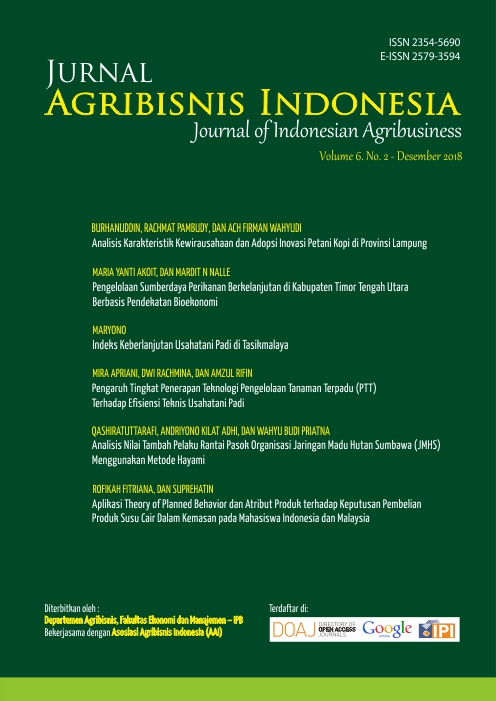INDEKS KEBERLANJUTAN USAHATANI PADI DI TASIKMALAYA
Main Article Content
Abstract
Downloads
Article Details
Jurnal Agribisnis Indonesia (JAI) is an Open Access Journal. The authors who publish the manuscript in this journal agree to the following terms:
Creative Commons License
JAI is licensed under a Creative Commons Attribution 4.0 International License. This permits anyone to copy, redistribute, remix, transmit, and adapt the work provided the original work and source are appropriately cited.
This means:
(1) Under the CC-BY license, authors retain ownership of the copyright for their article, but authors grant others permission to use the content of publications in Jurnal Agribisnis Indonesia in whole or in part provided that the original work is properly cited. Users (redistributors) of JAI are required to cite the original source, including the author's name, JAI as the initial source of publication, year of publication, volume number, issue, and Digital Object Identifier (DOI); (2) Authors grant JAI the right of first publication. Although authors remain the copyright owner.
References
Bell, S., dan S. Morse, 2008, Sustainability indicators: measuring the incommensurable?. Earthscan, London.
Bond, A., A. Morrison-Saunders, J. Pop, 2012, Sustainability assessment: the state of the art, Impact Assess Proj Apprais 30(1):53–6
BPS (Badan Pusat Statistik), 2017, Grafik Susenas Pertanian 2013 Indonesia, www.St2013.bps.go.id
COSCA (Committee on Sustainability Assessment), 2013, The cosa measuring sustainability report; Coffee and cocoa in 12 countries, Committee on Sustainability Assessment (COSCA), Philadelpia.
Eccles, R., I. Ioannou, and S. George, 2011, “The Impact of Corporate Sustainability on Organizational Processes and Performance.” Working Paper 12-035. Boston, MA: Harvard Business School
Fiksel, J., T. Eason, and H. Frederick, 2012, A Framework for Sustainability Indicators at EPA EPA/600/R/12/687. www.epa.gov/ord
Kolk, A., 2005, “Corporate Social Responsibility in The Coffee Sector: The Dynamics of MNC Responses and Code Development.” European Management Journal 23 (2), 228–236.
Muradian, R., and W. Pelupessy, 2005, “Governing the Coffee Chain: The Role of Voluntary Regulatory Systems.” World Development 33 (12), 2029-2044.
Nicoletti G, S. Scarpetta, O. Boyland, 2000, Summary indicators of product market regulation with extension to employment protection legislation, Economics Department Working Paper No 226, ECO/WKP(99)18
OECD (The Organisation for Economic Co-operation and Development), (2008), Handbook on constructing composite indicators: Methodology and user guide, Paris: OECD.
Petkova, I., 2006, “Shifting Regimes of Governance In The Coffee Market: From Secular Crisis to a New Equilibrium?” Review of International Political Economy 13 (2), 313–339.
Roy, R., N.W. Chan, R. Rainis, 2014, Rice Farming Sustainability Assessment in Bangladesh, Sustain Sciences 2014 9:31-44
Roy, R., N.W. Chan, S. Xenarios, 2015, Sustainability of Rice Production Systems: an Empirical Evaluation to Improve Policy, Environ Dev Sustain. DOI 10.1007/s10668-015-9638-x
UN (United Nation), 2015, Transforming Our World: The 2030 Agenda for Sustainable Development. A/Res/70/1. United Nation. www.Sustainabledevelopment.un.org

